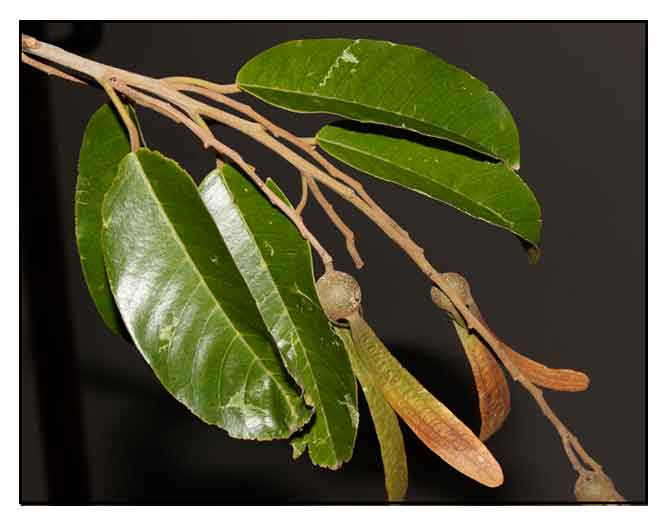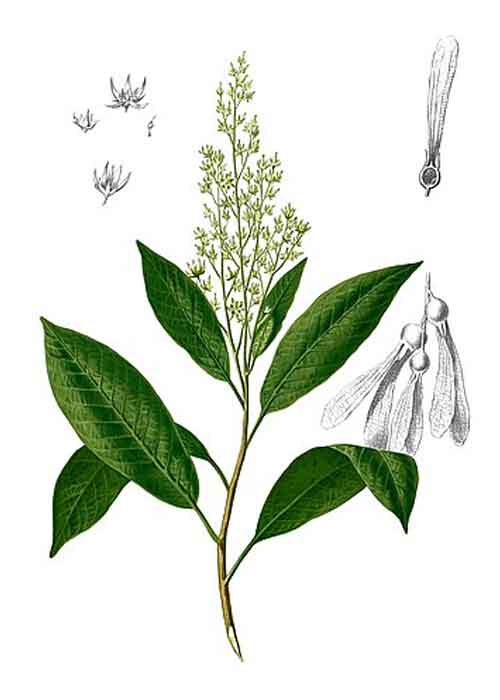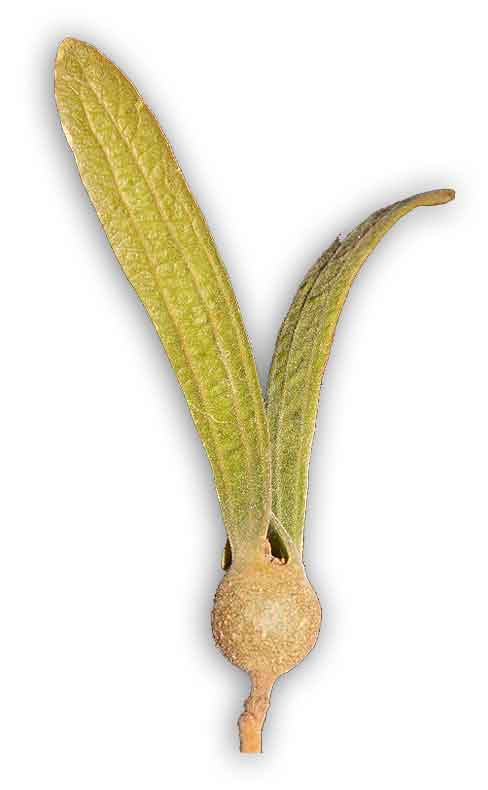 Gen info Gen info
- Anisoptera is a genus of plant in the family Dipterocarpaceae. - Etymology: Anisoptera derives from Greek anisos meaning "unequal" and pteron meaning "wing", referring to the unequal fruit calyx lobes.
- It contains ten species, eight of which are currently listed on the IUCN red list, four as critically endangered and four as endangered. (7)
- IUCN has categorized Anisoptera thurifera as Vulnerable.
- A 1990 study identified three Philippine anisoptera species: Anisoptera costata, A. aurea (previously A. mindanensis), and A. thurifera. (8)
- Study showed the solitary bee Megachile (Callomegachile) pluto Smith use resin to form beehive nest structures. (14) Fresh resin is said to protect bee nests from termites (Messer 1984).
 Botany Botany
• Anisoptera thurifera is a large-sized tree reaching a height of 40-45 m and a diameter of 140-180 cm. Bole is straight, regular, unbuttressed, three-fifths to two-thirds of the tree height. Bark is 15-25 mm thick, light gray with yellowish tinge and irregular flakes from the bottom. Canopy is dense during the rainy season and open in the dry, at which time it changes leaves. Leaves are elliptic and alternate with pointed apex and rounded base, light green beneath, 7.5-16 cm long and 3-7 cm wide. Fruit is rounded, 4 to 15 mm in diameter, with two wings that are 5-9 cm long and sometimes more than a cm broad. (2)
• A medium-sized to very large tree up to 60 m tall, bole branchless for up to 25 m, up to 200 cm in diameter and prominently buttressed; leaves 6-18 cm x 2.5-8.5 cm, elliptical to lanceolate or oblanceolate or obovate, greyish to brown lepidote beneath, with (10-)12-18(-20) pairs of secondary veins; flower bud lanceolate, stamens 35-57, stylopodium narrowly ellipsoidcylindrical, the apex puberulent. (5)
Distribution
- Native to the Philippines.
-
Widely distributed in the Philippines; dominant in primary forests.
- A major timber species in Papua New Guinea.
- Also native to Maluku, New Guinea, Sulawesi.
- IUCN listed as "Vulnerable."
Constituents
- Bioassay-directed isolation from leaves of Anisoptera thurifera and A. polyandra isolated three known resveratrol tetramers, (-)-hopeaphenol (1), vatalbinoside A (2), and vaticanol B (3). (see study below) (3)
Properties
- Study suggested anti-bacterial virulence, antiviral properties.
Parts used
Leaves, resin.
 Uses Uses
Edibility
- Seeds are edible; eaten raw or roasted. (2)
- In some parts of Papua New Guinea, the gum is used as chewing gum. (5)
Folkloric
- No reported folkloric medicinal use in the Philippines.
- Wood extracts believed to have tumor-inhibiting effects. (5)
- In Indonesia, buah taer was one of the plants used by the Tahit people to improve immunity during the COVID19 pandemic. (11)
Others
- Wood: Used for a variety of construction: shipbuilding, crates, flooring, oars, joinery, turnery, and manufacture of spools, barrels and baseball bats. (2)
- Resin: Tree yields a resin, collected by chopping into the tree to create a cavity for collection of the oil. The tree is reportedly tapped for a number of years. However, tapping of the tree results in entry of decay organisms and the ultimate death of the tree. Hence, tapped trees are often cut and used for timber before decay. (4) Resin used by bees for building beehive structures. (14)
- Palosapis oil: The resinous oil is called Palosapis oil (mersawa oil) and used as illuminant, for varnishing and for caulking boats. (4)
Studies
• Inhibition of Bacterial Virulence Type III Secretion System (T2SS) / Leaves: Study sought to identify compounds that inhibit the bacterial virulence type III secretion system (T3SS). Several fractions were identified from two Papua New Guinean Anisoptera species, showing activity against Yersinia pseudotuberculosis outer proteins E and H. Bioassay-directed isolation from leaves of Anisoptera thurifera and A. polyandra isolated three known resveratrol tetramers, (-)-hopeaphenol (1), vatalbinoside A (2), and vaticanol B (3). Compounds 1-3 displayed IC50 values of 8.8, 12.5 and 0.9 µM in the reporter-gene assay and IC50s of 2.9, 4.5 and 3.3 µM in the YopH assay, respectively, which suggested potential activity against T3SS in Yersinia. (3)
• (-)-Hopeaphenol / Leaves: A tetramer of resveratrol, (-)-hopeaphenol, was obtained from Anisoptera thurifera and Anisoptera polyandra leaves and shown to inhibit the secretion and expression of T3SS effector proteins in Yersinia pseudotuberculosis and Pseudomonas aeruginosa, and also affects their translocation into HeLa cells in a dose-dependent manner without affecting growth. (6)
• (-)-Hopeaphenol Activity Towards T3SS / Alternative Antibacterial Strategy: An alternative antibacterial strategy is to block bacterial virulence systems essential for ability to cause disease but not for general bacterial viability. Study has previously shown that (-)-hopeaphenol, a resveratrol tetramer, blocks the type III secretion system (T3SS) in the gram negative pathogens Yersinia pseudotuberculosis and P. aeruginosa. Using a panel of assays study showed that compounds with a benzofuran core structure i.e. viniferifuran, dehydroampelopsin B, anigopreissin A, dehydro-δ-viniferin and resveratrol-piceatannol hybrid displayed significant to moderate activities towards the T3SS in Y/ pseudotuberculosis and P. Aeruginosa. (9)
• Tapping of Palosapis for Resin Yield: Study reports on the tapping of palosapis for resin yield. Thirty-two species of palosapis, naturally growing in Real, Quezon, was tapped (boxed) for resin or oil yield. Factors affecting resin yield per tree were rainfall, diameter classes, and sulfuric acid concentration. Months with higher rainfall usually gave greater resin yield. Diameter was not statistically significant except in cases of 60 cm and over, which gave highest yield. Levels of acid concentration had not significant effect on resin yield. (10)
• Resveratrol Tetramers That Inhibit Bacterial Type III Secretion Systems / Anti-T3SS in Yersinia: The supply of (-)-hopeaphenol (1) was achieved via enzymatic biotransformation to provide material for preclinical investigation. Screening of prefractionated product sought to identify compounds that inhibit bacterial virulence type III secretion system (T3SS) with activity against Yersinia pseudotuberculosis outer proteins E and H (YopE and YopH). Bioassay-directed isolated from leaves of A. thurifera and A. polyandra yielded three known resveratrol tetramers, (-)-hopeaphenol (1), vatalbinoside A (2) and vaticanol B (3). Compounds 1-3 exhibited IC50s of 8.8, 12.5, and 9.9 µM in YopE and 2.9, 4.5, and 3.3 µM in YopH assays, suggesting potential against T3SS in Yersinia. Enzymatic hydrolysis of ß-glycoside 2 to aglycone 1 significantly enhanced yield of target bioactive natural product from 0.08% to 1.3% and facilitated ADMET studies of (-)-hopeaphenol (1). (13)
In the news
• Hopeaphenol / Anti-COVID / Anti-HIV: Prof Rali's collaborative research on hopeaphenol, a chemical compound found in Anisoptera thurifera tree, suggests possible potential and efficacy in treating diseases such as Covid-19 and HIV/AIDS. Ath the height of the 2020-2021 Covid pandemic, the compound was reported to have shown antiviral activity against several Covid variants. His study suggests almost 1% of the Anisoptera thurifera leaf content is hopeaphenol. (11)
Availability
Wild-crafted.
|

![]()




 Botany
Botany
